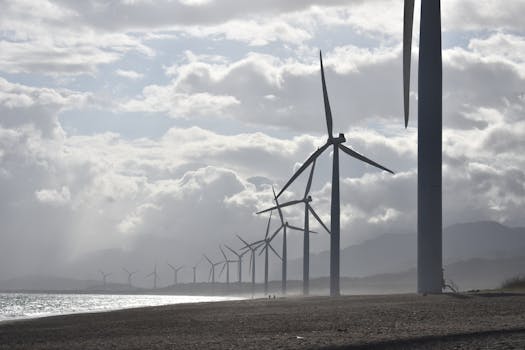As an affiliate, I earn from qualifying purchases, but this doesn't affect the reviews or recommendations—your trust is important to me!
Creating Your Own Wind Turbine Stem Kit at Home

Today, We're Making:
- - DIY Wind Turbine STEM Kit
- - 'Wind Powered Vehicle Challenge': Leveraging the DIY Wind Turbine STEM Kit, kids can attempt to build a lightweight vehicle powered solely by the energy generated by their wind turbine. This will encourage them to explore the principles of aerodynamics and mechanics while understanding the concept of converting wind energy into kinetic energy.
- - 'Weather Station': Encourage kids to build their own weather station to monitor wind speed and direction, temperature, and rainfall using simple household items along with their wind turbine. This project could help kids understand the science behind weather forecast and wind energy.
- - 'Solar vs Wind Energy': As this date falls around Earth Day, it's a great opportunity for kids to investigate the effectiveness of different forms of renewable energy. Kids can combine their wind turbine with a simple DIY solar panel and compare and contrast their efficiencies throughout different times of the day.
- - 'Wind Turbine Art Project': Integrate arts into the STEM project by challenging kids to design and decorate their wind turbines.
Do you remember when the thrill of hands-on science projects captivated your young heart?
Building miniature volcanoes, growing crystals, or crafting a solar oven for a school project is something we all remember. But today, we are stepping it up. Combining the enthralling world of physics with the ever-important environmental science, this blog post is your guide to creating a DIY Wind Turbine STEM Kit at home.
Creating your own Wind Turbine
It's not just a fantastic science experiment for your kid's next school project; it's also a step into the captivating realm of renewable energy and wind power. This engaging project will not only illuminate the principles of sustainable energy but also encourage individual power generation.
Plus, who knows, this wind turbine project might just pave the path for your home energy solutions!
Planning Your DIY Wind Turbine STEM Kit
Creating a DIY Wind Turbine STEM Kit is not as complex as it sounds. For a start, you need to gather the necessary materials. Generally, these include a small DC motor, LED lights, propellers, wires, and a dowel, among other items. Remember to have a clear outline of your Wind Turbine project; it can easily become an extraordinary Kid's Science Project. Also, understanding the concept of wind power is crucial when embarking on a DIY Energy Project. When studying wind technology, you'll explicitly cover how the wind's mechanical force turns the turbine's blades, creating kinetic energy converted into electricity.
The Allure of Renewable Energy
Venturing into the world of Homemade Wind Turbines is a great entrance towards understanding Renewable Energy. Unlike fossil fuels, wind energy is a form of sustainable energy that will not run out. By undertaking this DIY Stem Kit construction, children (and let's admit it, adults too!) can grasp the concept of how wind can power homes. It's an excellent opportunity to bring up discussions about low-cost energy, energy conservation, and green energy. Creating a Wind Turbine Stem Kit is a fascinating and practical way to introduce these themes in a fun and interactive manner.
The Science Behind Home Wind Turbines
Constructing a home wind turbine from your DIY Wind Turbine STEM Kit could be a daunting yet rewarding experience. It involves a little bit of mechanical engineering, physics, and electrical engineering. This Wind Turbine project is an excellent educational science experiment, combining multiple scientific principles. It might even spark an interest in science, paving the way for future discoveries in individual power generation. Learn about wind generators and the role they play in providing a sustainable, environmentally friendly solution to global energy needs.
Why Consider DIY Stem Kit Construction
STEM is an acronym that stands for Science, Technology, Engineering, and Mathematics. By creating a DIY Stem Kit, you're essentially making individual learning tools which can be shared with others, thereby fostering a proactive environment for educational growth. Creating your own Wind Turbine STEM Kit at home offers a deeper understanding of these vital areas. This project promotes active engagement, hands-on experience, and real-world applications that make the concept of Energy Science Project come alive.
Harvesting the Power of Wind
Embracing the concept of home energy solutions gives you a reason to explore the Wind Turbine Stem kit further. It enlightens you on the importance and possibilities of harnessing the wind's power for everyday use. Not only is it a great science experiment, but it's a look into future energy solutions. Wind energy is sustainable, renewable, cheap, and readily available. Plus, the science behind DIY home wind generation is truly fascinating! After successfully building a DIY Wind Turbine, you may find yourself dreaming about installing a large scale wind generator in your backyard. Now wouldn't that be something?

The Fantastic Science Experiment Journey of Constructing a Wind Turbine Stem Kit
And there you have it, the fantastic science experiment journey of constructing a Wind Turbine Stem Kit right from your home. Remember, it's not just about exploring renewable energy or creating a fun project.
Building and using your DIY Wind Turbine is a tangible example of how we can take control of our energy consumption and even contribute to preserving our beautiful planet. It's not just a chance to learn about the fascinating interplay of science, technology, and engineering, but also a unique opportunity for empowerment in the realm of sustainable living.
Who knows, the spark ignited today could be the beginning of a brighter, greener future in energy production! Keep exploring, keep creating and keep dreaming big. Because with a bit of wind in your sails, or should we say, in your turbine, anything is possible!

You May Also Like These:
Wind Powered Vehicle Challenge: Do-It-Yourself Wind Turbine STEM Kit
Ingredients:
- DIY Wind Turbine STEM Kit
- Balsa wood for the vehicle frame
- Four small wheels
- Axles (two skewers)
- Glue
- Tape measure
- Wind Source (a fan)
Instructions:
- Gather all the ingredients: Make sure you have everything ready before you start with the Wind Powered Vehicle project.
- Setup your Wind Turbine: Start by setting up your wind turbine following the instructions provided in the DIY Wind Turbine STEM Kit.
- Construct the Vehicle Frame: Using balsa wood, cut out shapes for your vehicle's body. It can be as simple as a rectangular shape. Make sure it's long enough to house your axles and wheels.
- Attach the axles and wheels: Attach your wheels to the skewers (axles) and then secure them to the body of your wind-powered vehicle using glue. Allow enough time for the glue to dry.
- Attach Wind Turbine: Once your vehicle is set, attach your wind turbine to it. Make sure to secure it properly so it doesn't fall off mid-run.
- Test your Vehicle: Finally, place your vehicle at the start line and turn on your wind source (fan). Note how the wind turbine powers your vehicle and see how far it goes. Repeat this process multiple times for best results.
Create a Homemade Thermometer
Ingredients:
- A clear, plastic bottle (500ml is ideal)
- Red, blue or green food coloring
- Water
- Rubbing alcohol
- A clear straw
- Modeling clay
- Thermometer markings printable
Instructions:
Step 1: Creating Mixture
- Fill about 1/4 of the bottle with equal parts of water and rubbing alcohol.
- Add a few drops of food coloring and stir the solution.
Step 2: Inserting the Straw
- Insert the straw into the bottle, but don't let it touch the bottom.
- Seal the neck of the bottle where the straw is inserted with the modeling clay. Make sure to not push the clay inside the straw.
Step 3: Testing and Calibrating
- Firstly, let your homemade thermometer sit for an hour to adjust room temperature.
- Compare your thermometer to a store-bought one. Note whether the liquid rises or falls with the increase or decrease of temperature.
- Finally, calibrate your thermometer using the provided printable or a store-bought thermometer.
1. Ice Cube Melting Experiment
Ingredients:
- Ice Cubes
- Three Bowls
- One Blanket
- One Piece of Aluminum Foil
- Stopwatch or timer
Instructions:
- Place one ice cube in each bowl.
- Leave the first bowl uncovered.
- Wrap the second bowl in a blanket.
- Wrap the third bowl in aluminum foil.
- Start the timer.
- Document how long it takes for each ice cube to melt.
2. Homemade Hand Warmers
Ingredients:
- Ziplock Bags
- Calcium Chloride Ice-Melt Pellets
- Water
Instructions:
- Fill a ziplock bag halfway with calcium chloride ice-melt pellets.
- Insert another smaller ziplock bag with water inside the first bag.
- When ready, pop the water bag and let it mix with the calcium chloride glass to create a warming reaction.
- Observe and record the temperature change with a thermometer.
Solar vs Wind Energy: Weather Forecasting and Wind Energy STEM Project
Materials Needed:
- Anemometer (can be homemade or purchased)
- Wind turbine kit (can be found online)
- Solar energy kit (can be found online)
- Stopwatch
- Rain gauge
- Notebook and pen for tracking observations
Instructions:
- Set up your anemometer and your wind turbine following their respective instruction manuals.
- Observe the wind direction and record it in your notebook.
- Watch the anemometer for one minute using the stopwatch and record the number of rotations, this will give you the wind speed.
- Use the wind speed data to predict and record how much energy your wind turbine would be expected to generate.
- Next, set up your solar energy kit and place it in a sunny location.
- Using the solar energy kit's manual, record how much energy the solar panel is expected to generate.
- Next time it rains, use the rain gauge to measure rainfall.
- Record your rainfall data and use it to predict how the weather might affect solar and wind energy production.
Reflection:
- Compare your predictions with the actual energy generation data from your wind turbine and solar energy kit.
- Discuss the benefits and drawbacks of both types of energy generation in light of your observations.
- Consider the effects of weather on energy production. Which type of energy seems most reliable based on your data?
Wind Turbine Art Project
Objective:To integrate arts with STEM project by designing and decorating a wind turbine.
Materials:
- Cardboard
- Scissors
- Markers, Paints, Glitter or other decorative items of your choice for decorating
- An LED light or small fan
- Wire for connecting the turbine with the LED or fan
- A dowel
- Tape or glue
Instructions:
Part 1 - Create the Wind Turbine:
- Cut the Cardboard: Take the cardboard and cut blades for the turbine. A simple wind turbine has three blades but kids can experiment by creating turbines with more blades and checking their performance against turbines with lesser blades.
- Decorate the blades: Here comes the art part. Children can decorate the blades with markers, paints and glitter. It's a good idea to do this part before assembly to reach all parts of the blades easily.
- Attach the Blades to the Dowel: Tape or glue the finished blades to the dowel. Make sure it's properly secure before moving onto the wiring part.
Part 2 - Wire up the Turbine:
- Wire the Turbine: Connect the base of the dowel with wires that are further connected with either an LED light or a small fan.
- Test the Turbine: Finally, to test the turbine, put it outside in the wind or simulate wind indoors using a fan.
Conclusion:
By the end of this activity, children are not only exposed to knowledge about renewable energy sources, but they also get to put their creativity to good use by designing and decorating their own wind turbines.











